Balance: It’s Not Just Tree Pose
“The reason we think balance is associated with longevity is because it requires keeping your brain and nervous system’s integration circuitry intact.” —Danine Fruge, MD, family-practice physician
Practicing specifically for better balance is important for us at any age, but it is essential for those of us over 50 or 60, when so many changes happen in our bodies. To work on balance with yoga, Tree pose is a common choice. Although Tree Pose is iconic, often representative of yoga in general, there are many other diverse and entertaining ways to improve balance. With better balance, we avoid falls, which can lead to injuries and a serious decline in overall health. In this post I’ll describe to you some of my top choices for practicing basic balance skills that will help you in daily life and in your Tree pose.
To get the bad news out right away, here are the most common changes that happen gradually as we age:
- Less acuity in the nervous system (which could manifest as slower response time reduced coordination, reduced sensory and motor efficiency, and cognitive decline)
- Blood pressure deviations from normal levels
- BPPV: benign paroxysmal positional vertigo, in which small stones in inner ear become dislodged, is common in over 60
- Reduced circulatory efficiency and reduced elasticity of blood vessels
- Peripheral neuropathy (poor nerve conduction in the hands and feet)
- Loss of muscle strength (called sarcopenia) and stiffening of the connective tissues
- Loss of bone density (osteopenia or osteoporosis)
- Degeneration and stiffness of joints due to wear and tear (osteoarthritis)
- Poor balance, resulting from all of the above
We need balance skills to avoid falling. According to the National Council on Aging, falling is the leading cause of fatal and nonfatal injuries among older adults. The most common locations for these fractures are the hip, pelvis, ankle, wrist, and upper arm bone near the shoulder.
To catch ourselves when we might fall, we need flexibility and coordination to suddenly regain our balance. If we do fall, we need strength to catch ourselves. Fall prevention must include all of these elements of balancing: strength, flexibility, and coordination. And the bonus is that when we develop these skills, we contribute to our agility in daily life. Doesn’t that also sound like the same list as the benefits of a good yoga practice?
Our Three Balance Mechanisms
We have three mechanisms in the body that work simultaneously, moment to moment, to help us maintain balance. As the opening quote says, we need the brain and body to be talking to each other.
First, our proprioception sends neural signals from our muscles and joints to the brain that indicate what position we are in. For this to work well, we need sufficient body awareness and focus to receive those signals and make adjustments when needed. Many older adults have reduced proprioception and possibly also peripheral neuropathy, which is a lack of sensation and motor control in the feet. Our feet may feel numb or unable to move in the ways their design allows. Another common aging issue related to proprioception is a general slowing of perceptual and cognitive function. We may not perceive an impending loss of balance soon enough to prevent a fall. But evidence shows that these conditions can be at least partially reversed by regular exercise. The brain can keep learning!
Secondly, the delicate structures in the inner ear respond to changes of position (particularly of the head) and communicate with the brain. This is called the vestibular system, and it changes with the aging process.
Thirdly, our visual sense gives us a feeling-sense of orientation to gravity and the environment around us. We need to remember to maintain our attention and our visual focus (both direct and peripheral), whether walking on the street or doing any kind of exercise. This may seem obvious, but you can ask yourself: how often do I become involved with an internal reverie while doing my daily activities or while walking outside, either in the city or in the country? If that inattention becomes a persistent habit, it can increase your risk of falling.
If you suddenly develop a balance issue, such as dizziness or light-headedness when going from lying down to standing up, or if you have reduced sensation in your feet, I recommend that you seek medical help to consider inner ear, problems, neuropathy, medication side effects, or cardiovascular issues. However, a gradual development of balance problems is most likely to be caused by our normal aging process. This is where yoga can help.
With yoga, you improve your proprioception, you strengthen your muscles, and you increase your flexibility. I’ve mentioned why proprioception and muscle strength are important. But why flexibility? When you sense that your balance is off, the natural tendency is to adjust your position to regain your balance. This could be catching yourself with one foot after tripping over an obstacle or widening your stance while walking down the aisle of a fast-moving train. In order to do that, you need fast responses, but also hip and leg mobility. Flexibility allows you a greater range of adaptive moves to steady yourself and prevent a fall. For this reason, your yoga practice must include exercises for dynamic balancing, which I believe is just as important as learning to balance on one foot in stillness.
Alignment matters. What is your personal optimal posture, given all the variations that exist in humanity? How do you tend to arrange your body when standing, walking, and doing all your daily activities? I’ve seen some common non-optimal tendencies in my years of teaching, such as turning the knees inward or the feet outward, pushing the pelvis forward, sinking in the lower or upper back, rolling the shoulders forward, and carrying the head forward with the neck shortening. Each of these deviations from optimal alignment can predispose us to losing our balance.
I recommend that you consult a trained teacher to help you evaluate your posture. But here are some basic guidelines:
- Your weight is well balanced on your feet. You place your feet with the center line of one foot parallel to the center line of the other foot. If your habit is to turn your feet inward or outward, gradually work to become more familiar with this neutral position of parallel feet. (See the Four Corners exercise below.)
- Your knees face toward your middle toes, whether your legs are bent or straight. (See the Knee Tracking exercise below.)
- The tilt of your pelvis is appropriate for your body and the pose you are doing. Find the midpoint between an excessive lumbar (lower back) arch, and the opposite pattern of excessively tucking your tailbone.
- You maintain abdominal support, without losing the slight arch inward in your lower back.
- Your front chest is lifted and broad, with the muscles around your shoulder blades supporting your upper back.
- Your head aligns over your spine as much as possible. If you tend to carry your head forward, move your head back, first with the base of your ears moving back, then lifting your chin to recover the slight arch in your neck.
- You enliven your whole body with the energy from your breath and your highest intention for your well-being. Be fully present in your body.
What is “The Core” and Why is it Important?
The prevailing definition of “core” is your abdominal muscles. Within the fitness and medical community, there is a tendency to overemphasize abdominal strengthening through sit-ups, crunches, or some variation of those common exercises. For anyone with low bone density, this type of exercise is dangerous, because it puts excess pressure on the front part of the vertebrae as you curve your spine.
But there is another way to understand the core—to see it as including the muscles of the spine, hips, pelvic floor, thighs, and the abdominal wall. These core muscles stabilize the middle of our body on all sides, creating a source and center for the movements of the rest of the body. With a weak core, your body will find other, less efficient strategies for stability, such as tensing your shoulders. With a strong core, you’ll have much more stability and support for any situation, especially vigorous activities—but also for daily chores or extensive sitting at work. And most of all, you’ll have better balance.
One action that may be unfamiliar to many people is the lift of the pelvic floor. This is a muscular network at the base of your pelvis that we use to stabilize our center in the yoga poses. Right now, as you’re reading, squeeze the muscles there and see how it feels. Notice that you can continue to breathe while firming those muscles. You can squeeze toward the center, and then gently lift that floor upward. Practice this for 15 seconds at a time at first, and then gradually integrate it into your practice.
Here are some exercises that you can do as a warmup for your usual practice, with special attention to balance improvement.
My favorite core strengthening yoga pose is a dynamic supine twist, a variation of Jathara Parivartanasana. I like it because people or any age can do it, and all the core muscles are strengthened without spinal flexion.
Supine Twist (Jathara Parivartanasana)
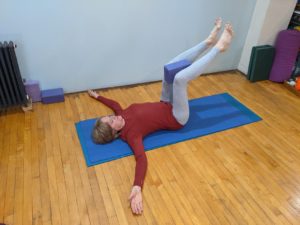
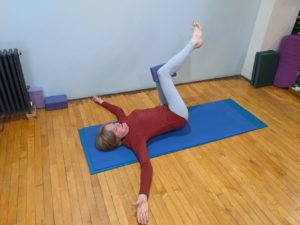
Purpose: To strengthen the core muscles of the spine and torso, and learn to twist with a long spine
Props: Yoga mat and optional blanket under your pelvis or head and neck for comfort
Body position: On your back, knees bent, arms stretched to the sides, palms facing up
Instructions:
- Bend your knees and place a block between them (narrow, medium, or wide setting, your choice), keeping your feet at least as high as your knees, or higher. Squeeze the block.
- Flex your ankles and spread your toes.
- Press your arms and shoulders down into the mat to stabilize your upper torso.
- Move your legs at a moderate pace from right to left, breathing smoothly. Begin by moving a small amount and increase how far you twist as you feel ready.
- When you are tired, come back to center, remove the block, place your feet flat, and rest.
Things to watch for:
- Keep your shoulders on the floor and notice the strengthening actions in your twisting muscles (spine and abdomen). This is very good core work, because you are working dynamically through a range of movement, while stabilizing.
- Notice that the floor helps you to maintain a long spine.
- Keep your neck neutral: not pressing it down or lifting it up.
These three exercises prepare our knees, ankles, and feet to have the coordination and strength to support us.
The Four Corners of the Feet
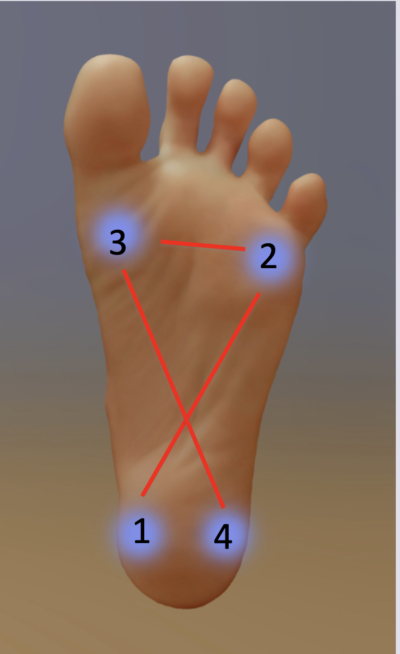
Purpose: To balance your weight well on your feet and strengthen the intrinsic foot muscles.
Props: The floor
Body position: Standing
Instructions:
Begin by standing in a “normal” way and feel the balance of weight on your feet. Do you tend to place more weight on one foot in comparison to the other? More weight in one part of the foot?
Next, work with one foot at a time in the following way:
- Put most of your weight on one foot. With the other one, tilt your foot so that the inner heel is the only part touching the floor.
- Then keep that part down and put the base of your little toe down (at the joint at its base). Notice how various muscles in the sole of your foot (called intrinsic muscles) are working as you do these steps.
- Keeping those two points down, widen across the forefoot to bring the base of your big toe down. Notice how it feels to widen your foot in this way.
- With those three points staying down, press your outer heel down.
- Feel how the weight balances on these four corners. You might play with the four corners, moving through the sequence like a dance. Experiment with balancing on that foot.
- Repeat this sequence with your other foot.
Things to watch for:
- How do your feet feel different after doing this?
- Which corners are easiest for you to find and press down? Which are less easy?
- What does this tell you about your usual posture on your feet?
- What do you feel in your knees and hips as you do this?
Knee Tracking
![]()
Purpose: To align your knees well as they bend, for safety, balance, and strength in the poses
Props: The floor
Body position: Standing
Instructions:
- Stand with your feet balanced on their four corners and place them hip-width apart.
- Bend your knees and look down to see where the kneecaps are pointing. Adjust them so that they point toward the second or third toe.
- Practice this several times, observing the knees as they bend.
Things to watch for:
- For many people, the knees may turn in toward the midline. What is your habitual pattern?
- What do you have to do differently than usual to align your knees in this way?
- Where in your body do you feel the actions that are needed?
Heel Lift
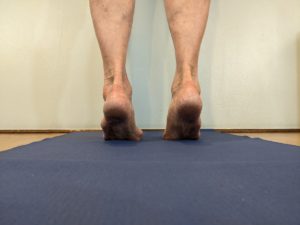
Purpose: To strengthen the sides of the ankles for better balance
Props: A wall or some other surface you can touch for balance support
Body position: Stand facing the wall, touching it lightly with your fingertips, or stand next to another support (a chair or table)
Instructions:
- Touching your support lightly for balance, lift your heels, coming onto your toes, especially the first three toes. Feel the supportive action of your ankle muscles on both sides, as you lift the heels straight up.
- Bring your heels back to the floor and repeat this action several times until your muscles fatigue.
- Once you are comfortable with this heel lift, also spread your toes.
Things to watch for:
- Keep your weight mostly on your first three toes. If the weight moves to the outer toes, the ankles will wing out, and you will lose the purpose of the exercise.
The last exercise is a playful one, giving you the coordination you need to recover your balance before you fall.
Dynamic Balancing
Purpose: To simulate balance challenges in daily life
Props: A wall or chair back
Body position: Standing
Instructions for Part 1:
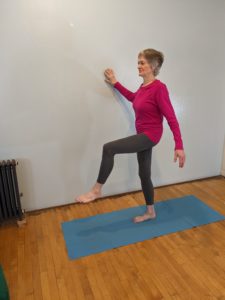
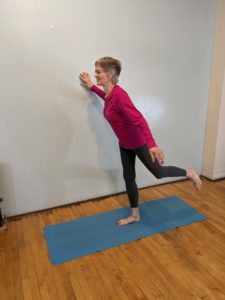
You can do this exercise while touching a wall or a chair, or free standing.
- From standing on two feet, bring your weight to one leg and swing the other leg gently forward and back. Try different speeds.
- Focus your gaze strongly on one spot in front of you and engage your core to stabilize your balance.
- Bring the lifted leg down and repeat on the other side.
Instructions for Part 2:
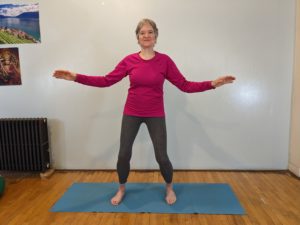
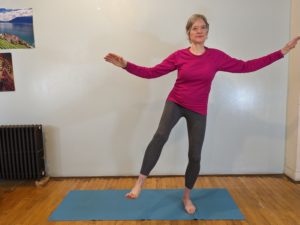
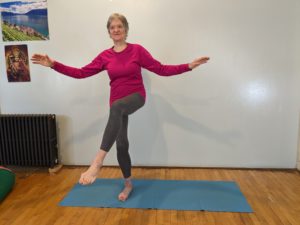
- Move away from the wall, and stand facing out into the room, with feet several inches apart so that you can easily move side to side.
- Start by lifting your right foot and take a wide sideward step to the right, placing your right foot down and shifting your weight on the right foot so your left foot is in the air. Leaving your left foot in the air, balance there for a few seconds.
- Then bring the left foot down into another wide side-step, this time to the left. Once you place your left foot down and shift your weight onto your left foot, hold your right foot in the air for a few seconds. Then bring the right foot down.
- Repeat this pattern, varying the distance and the speed. Focus on how you find and sustain your balance on one leg.
- Continue for as long as you wish.
Things to watch for:
- Concentrate on the strength of your standing leg, and don’t worry about your appearance. The important thing is building your skill to recover your balance when it begins to go off center. Be playful!
This post is excerpted from my book titled “Empowered Yoga: Everyday Yoga Practices for Bone Health, Strength and Balance,” published by Emerald Lake Books in fall of 2023.
Note: This post was originally published on Nina Zolotow’s blog, “Yoga for Times of Change.”

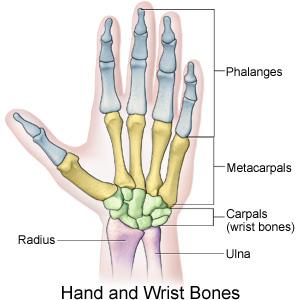
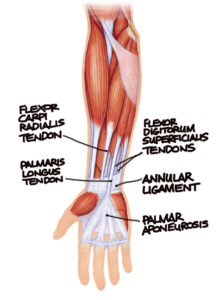
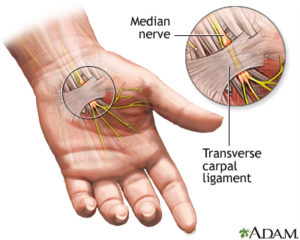
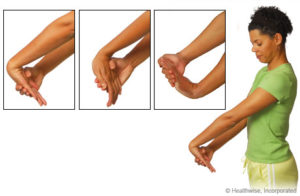
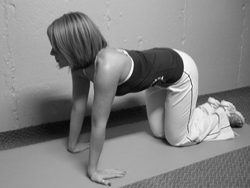
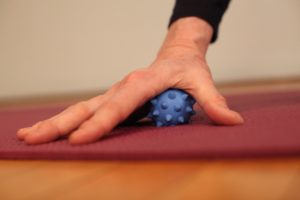

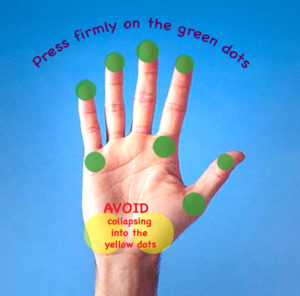
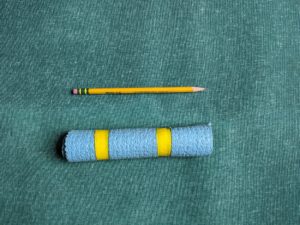
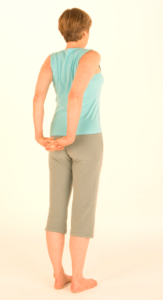
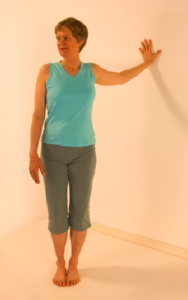
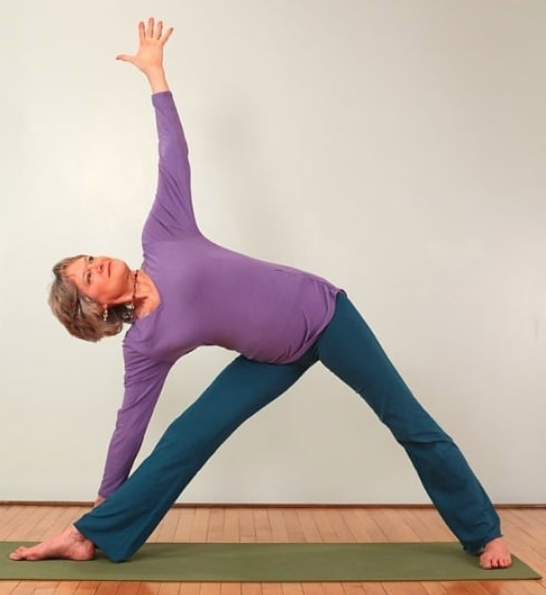
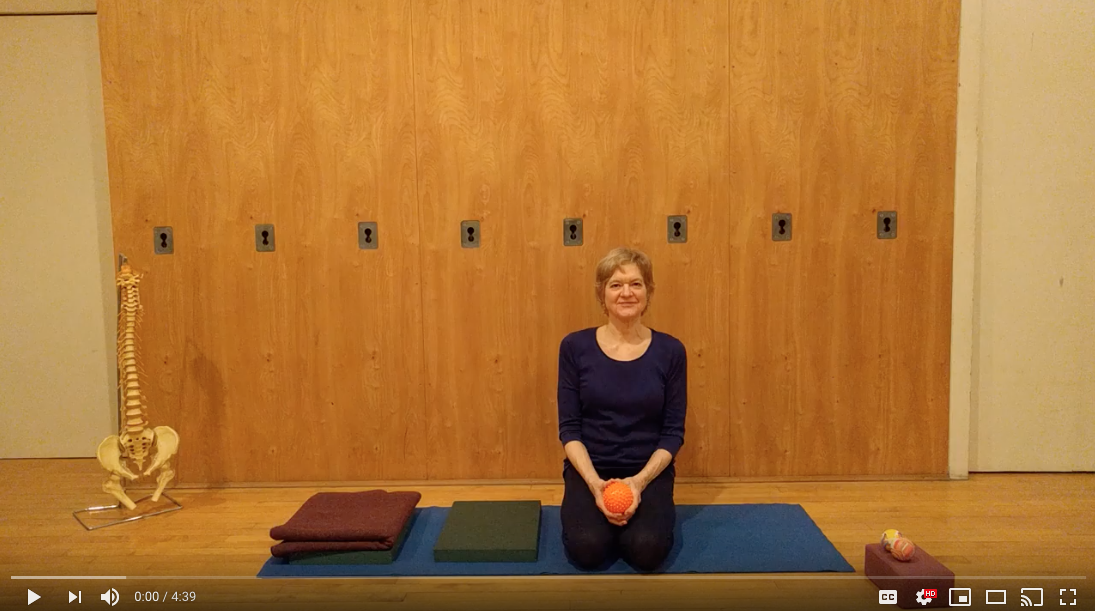
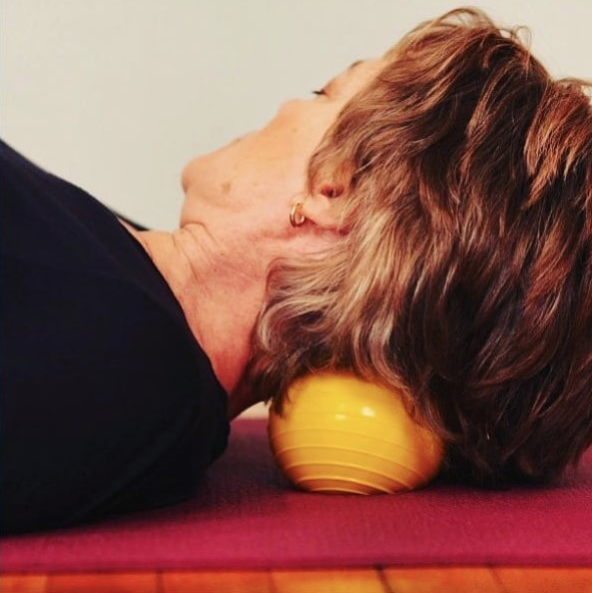 How’s your interoception? In case you’re not familiar with that word, it’s the inner felt sense of the body, including being warm or cold, hungry or full, tired or energized, stiff or flexible. Interoception is increasingly seen as a crucial component of health by twenty-first century researchers, especially in how it bridges the gap between physical and emotional experience. Recent research shows that well-developed interoception can lessen our experience of pain, which might surprise you. In other words, the more we are in touch with our inner world of sensation, the more we can adapt our behaviors to lessen the causes of pain. When our interoception is faulty and we are disconnected from the body, we are more vulnerable to anxiety and depression.
How’s your interoception? In case you’re not familiar with that word, it’s the inner felt sense of the body, including being warm or cold, hungry or full, tired or energized, stiff or flexible. Interoception is increasingly seen as a crucial component of health by twenty-first century researchers, especially in how it bridges the gap between physical and emotional experience. Recent research shows that well-developed interoception can lessen our experience of pain, which might surprise you. In other words, the more we are in touch with our inner world of sensation, the more we can adapt our behaviors to lessen the causes of pain. When our interoception is faulty and we are disconnected from the body, we are more vulnerable to anxiety and depression.
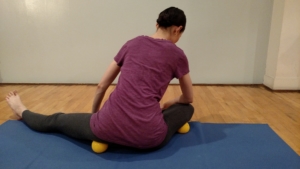
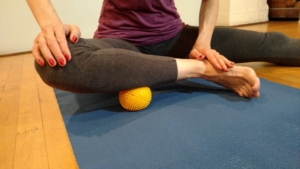
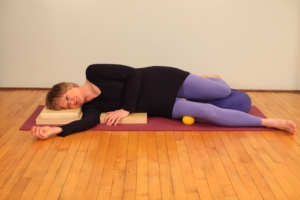 3. Lying on your side with one 3-4” hollow ball: Start by arranging props to support your upper body well while lying on your side. In this photo I have one pad under my ribs, two under my head, and a space between them for my shoulder.
3. Lying on your side with one 3-4” hollow ball: Start by arranging props to support your upper body well while lying on your side. In this photo I have one pad under my ribs, two under my head, and a space between them for my shoulder.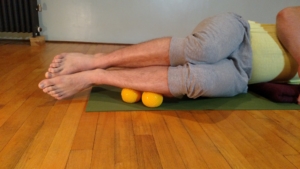 4. Lying on your side with two small solid balls under the side of your lower leg: Support your upper body in the same way as in #3 above.
4. Lying on your side with two small solid balls under the side of your lower leg: Support your upper body in the same way as in #3 above.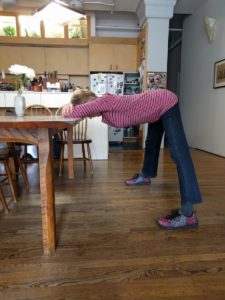 Prasarita Padottanasana: With feet spread wide apart, stretch your legs and reach your hips back as you stretch your torso forward. Rest your head on the table with your arms folded. Breathe and quiet your mind as you connect with sensations inside.
Prasarita Padottanasana: With feet spread wide apart, stretch your legs and reach your hips back as you stretch your torso forward. Rest your head on the table with your arms folded. Breathe and quiet your mind as you connect with sensations inside.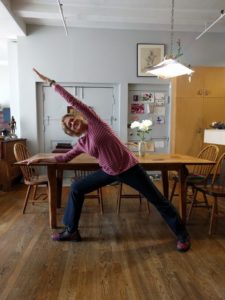 Parsvakonasana with your back to the table: With your right leg turned out parallel to the table, bend the right knee, pointing it toward the middle toes. The other hips shifts forward slightly, away from the table. Lean to the right with the right arm on the table. Keeping your legs and abdomen strongly active, bring your torso to the side as far as you wish. Stretch your left arm alongside your head, reaching vigorously from hand to foot. Repeat on the other side.
Parsvakonasana with your back to the table: With your right leg turned out parallel to the table, bend the right knee, pointing it toward the middle toes. The other hips shifts forward slightly, away from the table. Lean to the right with the right arm on the table. Keeping your legs and abdomen strongly active, bring your torso to the side as far as you wish. Stretch your left arm alongside your head, reaching vigorously from hand to foot. Repeat on the other side.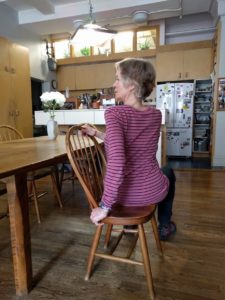 Seated twist with chair: Sit sideways in the chair, with your spine erect and legs steady. Inhale, lift your spine, and exhale, twist toward the back of the chair. Place your hands wherever it helps you to twist more. Hold for a few breaths, and repeat on the other side.
Seated twist with chair: Sit sideways in the chair, with your spine erect and legs steady. Inhale, lift your spine, and exhale, twist toward the back of the chair. Place your hands wherever it helps you to twist more. Hold for a few breaths, and repeat on the other side.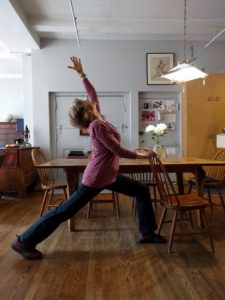 High lunge with the chair: Face the back of the chair and step your right foot forward, your left foot back. Both legs are parallel and the back heel will be off the floor. Face your pelvis squarely toward the chair, and hold the back of the chair with your hands. Lean forward a bit and push into the back leg, widening inside your pelvis and hips. Then pull down through the back of the pelvis as you lift up in the front torso. Raise your chest, look up, and expand from the top of your head all the way to the back foot. Raise your left arm up, and possibly also your right arm. Enjoy your strong and expanded self, then release and repeat on the other side.
High lunge with the chair: Face the back of the chair and step your right foot forward, your left foot back. Both legs are parallel and the back heel will be off the floor. Face your pelvis squarely toward the chair, and hold the back of the chair with your hands. Lean forward a bit and push into the back leg, widening inside your pelvis and hips. Then pull down through the back of the pelvis as you lift up in the front torso. Raise your chest, look up, and expand from the top of your head all the way to the back foot. Raise your left arm up, and possibly also your right arm. Enjoy your strong and expanded self, then release and repeat on the other side.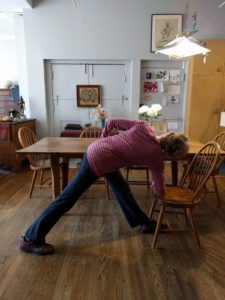 Parivrrta Trikonasana with the chair and tabletop: Place the chair sideways next to the table, the seat facing you, as shown. Step your left leg forward and keep both legs straight. Reach your hips back and your chest forward as you place your right hand on the chair seat. Twist toward the table, with your left hand pressing down into the tabletop to help empower your twist. Breathe several times, then come out of the twist and repeat on the other side.
Parivrrta Trikonasana with the chair and tabletop: Place the chair sideways next to the table, the seat facing you, as shown. Step your left leg forward and keep both legs straight. Reach your hips back and your chest forward as you place your right hand on the chair seat. Twist toward the table, with your left hand pressing down into the tabletop to help empower your twist. Breathe several times, then come out of the twist and repeat on the other side.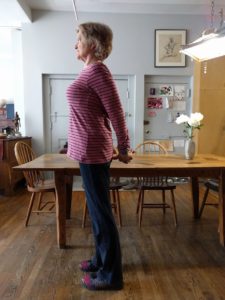 Shoulders and arms pulling back: Stand tall, roll your shoulders back and clasp your hands behind you. Pull your arms back to find a stretch in the front of your shoulders, and a supportive strength in the upper back. Take several deep breaths, feeling all inner sensations as you hold the pose.
Shoulders and arms pulling back: Stand tall, roll your shoulders back and clasp your hands behind you. Pull your arms back to find a stretch in the front of your shoulders, and a supportive strength in the upper back. Take several deep breaths, feeling all inner sensations as you hold the pose.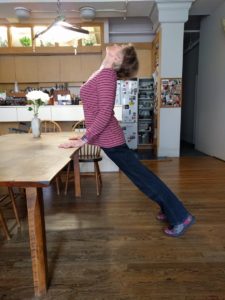 Upward facing dog with hands on the table: Place your hands on the edge of the table and walk your feet back. As you bring more weight onto your arms, be sure to keep your shoulders back and your chest lifted. Bend your elbows a bit, bring your pelvis toward the table with your tailbone lengthening, and move your chest forward between your arms, as if going through a doorway. Look up if you can, and enjoy a full stretch from your chin to your toes.
Upward facing dog with hands on the table: Place your hands on the edge of the table and walk your feet back. As you bring more weight onto your arms, be sure to keep your shoulders back and your chest lifted. Bend your elbows a bit, bring your pelvis toward the table with your tailbone lengthening, and move your chest forward between your arms, as if going through a doorway. Look up if you can, and enjoy a full stretch from your chin to your toes.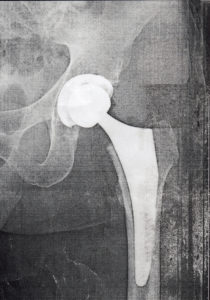
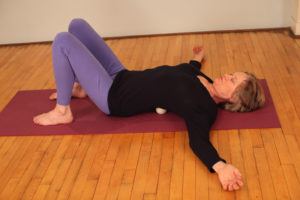 What do you do to take a break from daily stress, body aches, worry and fatigue? Maybe it’s a cup of tea, a phone call with a friend, or a few minutes of yoga. I recommend that you add this to your choices: a Bodymind Ballwork technique for the spine which will de-stress you, lengthen your back, and refresh your breath and your mind. I do it every day, as do many of my students.
What do you do to take a break from daily stress, body aches, worry and fatigue? Maybe it’s a cup of tea, a phone call with a friend, or a few minutes of yoga. I recommend that you add this to your choices: a Bodymind Ballwork technique for the spine which will de-stress you, lengthen your back, and refresh your breath and your mind. I do it every day, as do many of my students.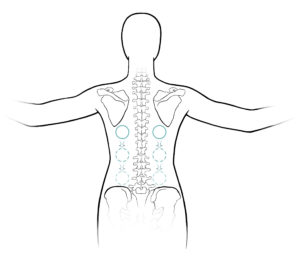 Now move your back very slowly to one side, just an inch or two. Try to move only that segment of your back where you feel the balls. Breathe as you go, and notice any sensations, strong or subtle. The balls are massaging your spinal muscles, of which there are many, and all the surrounding fascia which is richly innervated. Some areas will probably be sore, others not. Think of it as an exploration of your own self, your back body which you can never actually see, but you can deeply feel.
Now move your back very slowly to one side, just an inch or two. Try to move only that segment of your back where you feel the balls. Breathe as you go, and notice any sensations, strong or subtle. The balls are massaging your spinal muscles, of which there are many, and all the surrounding fascia which is richly innervated. Some areas will probably be sore, others not. Think of it as an exploration of your own self, your back body which you can never actually see, but you can deeply feel.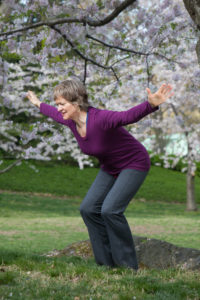 The teams of muscles that support and move your hips are awesome. Even if you’re not an anatomy geek, they are worth getting to know. You have the flexors in the front (with the iliopsoas as the team leader) which bring your leg forward to take a step. Their counterpart is the extensors in the back – gluteus maximus and hamstrings – the push-off muscles for running. We also have teams that rotate the hip joint – external rotators (piriformis being the midget but strong team leader here) and the internal rotators, which I’ll talk about below. Another team is the adductors on the inner thighs, a group of five that stabilize the inner thighs, pulling toward the midline.
The teams of muscles that support and move your hips are awesome. Even if you’re not an anatomy geek, they are worth getting to know. You have the flexors in the front (with the iliopsoas as the team leader) which bring your leg forward to take a step. Their counterpart is the extensors in the back – gluteus maximus and hamstrings – the push-off muscles for running. We also have teams that rotate the hip joint – external rotators (piriformis being the midget but strong team leader here) and the internal rotators, which I’ll talk about below. Another team is the adductors on the inner thighs, a group of five that stabilize the inner thighs, pulling toward the midline.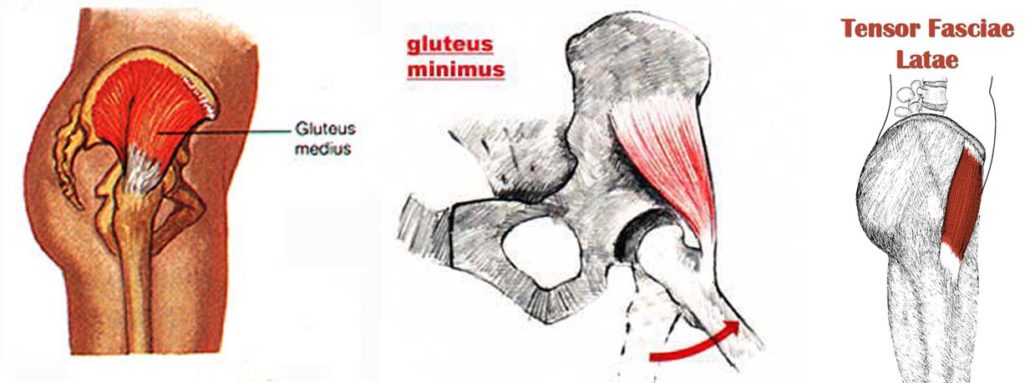
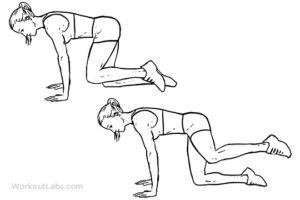
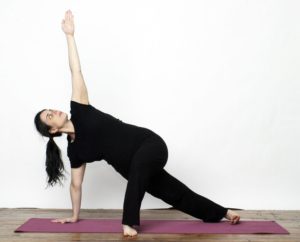
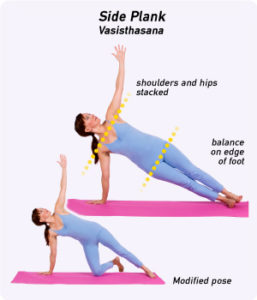
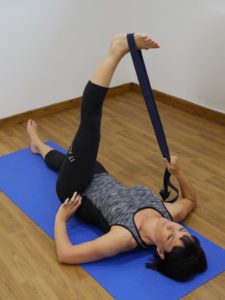
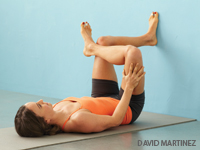
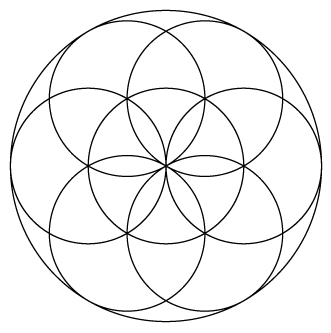 At the end of a year, we can reflect on the passage of time, reviewing the events and growth of the past year and setting intentions for the next year. It’s a valuable time to renew values and goals, and to savor meaningful experiences. What did I enjoy this year? What do I want to do more or less of next year? What mistakes did I learn from? What obstacles did I overcome, and which ones are still ahead?
At the end of a year, we can reflect on the passage of time, reviewing the events and growth of the past year and setting intentions for the next year. It’s a valuable time to renew values and goals, and to savor meaningful experiences. What did I enjoy this year? What do I want to do more or less of next year? What mistakes did I learn from? What obstacles did I overcome, and which ones are still ahead?